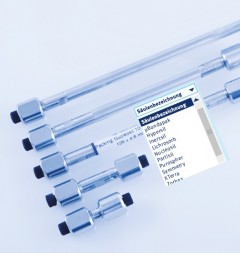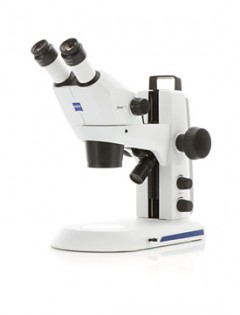|
Forscher
>
Thomas Heidebach
>
Targeting the gut
Targeting the gutNovel milk protein-based microparticles as vehicles for bioactive ingredients
Michael Betz, Thomas Heidebach, Prof. Dr. Ulrich Kulozik, Chair for Food Process Engineering and Dairy Technology, Technische Universität München, Germany Microencapsulation in Food Technology
Microencapsulation is defined as a process for entrapment of substances (core-material) in capsules or matrices, which release their contents depending on specific environmental conditions. This definition induces associations to the pharmaceutical principle of encapsulation. Literally, the pharmaceutical technology is the big brother of microencapsulation in the food sector. However, the prefix “micro” indicates that food-related encapsulation systems are generally smaller than their pharmaceutical analogues.
Milk proteins for the assembling of microcapsules Milk proteins can be used in form of two main fractions: the caseins and the whey proteins (cf. Fig. 2).
The two fractions possess numerous technologically interesting and useful properties. For instance, aqueous solutions of caseins or whey proteins are capable of forming gels, which are a suitable matrix material for microcapsules (cf. infobox). A key component for the thermal gelation of whey proteins is β-lactoglobulin. Aqueous β-lactoglobulin solutions have the ability to form hydrogels even at very acidic conditions below pH 2. For Dipl.-Ing. Michael Betz this is an ideal precondition of encapsulating the bioactive plant compounds, which show their highest stability under these extremely acidic conditions (cf. Fig. 1). Dipl.-Ing. Thomas Heidebach has adapted two enzymatic methods for the generation of casein gels to microencapsulation. The temperature and pH-conditions for both procedures are very gentle, making them ideal for the encapsulation of sensitive probiotic microorganisms. On the one hand he uses the enzyme transglutaminase (Tgase) for the generation of gels from concentrated casein solutions, on the other hand he applies the principle of rennet gelation of milk. For the production of microcapsules the scientists make use of a well known thermodynamic phenomenon: the immiscibility of oil and water. The emulsification process for the production of microcapsules Fig. 3 schematically depicts the different steps of the emulsification process. At first, an aqueous matrix solution composed of milk proteins and core-material (and in case of enzymatic gelation the specific enzyme) is emulsified in vegetable oil. A water-in-oil-emulsion is formed. Secondly, the milk protein solution which is dispersed in the oil phase is converted from liquid to solid state by inducing gelation. In addition, the obtained hydrogel microspheres are removed from the oil phase by centrifugation. The size of the generated microcapsules plays an important role for their application. On the one hand they have to be small enough to be imperceivable during ingestion. On the other hand their stabilising and protective effect is improved when the capsule-diameter is increased. Thus, for each field of application the optimum capsule size has to be determined. By variation of the emulsifying intensity during the emulsification process microcapsules in the size range of 20 ?m to 1 mm can be produced and adapted to specific requirements of product and corematerial.
Microencapsulation of probiotics To ensure that probiotics unfold their full potential inside the human body they have to reach their target point of action in an active state and in sufficient amounts. Microorganisms, in particular, have to overcome several obstacles. Hitherto, probiotics are added to foods like yoghurts in a dried or frozen form. However, when the bestbefore- date of the products is reached the concentration of contained microorganisms has strongly decreased. Acids contained in the yoghurt harm the living microorganisms during storage, and after ingestion the gastric acid poses a threat for the probiotics. For this reason, only a fraction of the microorganisms which were initially added to the yoghurt reach their target location, the gut. This problem can be solved by microencapsulation. By means of entrapment in milk protein gels, the stability and survival rate of the probiotics under detrimental acidic conditions can significantly be improved, as fig. 4 depicts [1,2].
Microencapsulation of bioactive plant compounds While microorganisms are retained within the relatively close-meshed milk protein gels due to their size, most bioactive plant compounds are of low molecular weight and are therefore able to migrate through the gel network. Fig. 5 shows the consequence, namely the diffusive release of the core-material in aqueous environment [3].
This seems to be a challenge, when such low- molecular compounds are to be encapsulated. Or is it a chance rather than a problem? To answer this question it is necessary to take a closer look at the properties of the bioactive plant compounds, which in the present case is bilberry extract. Bilberries contain large amounts of secondary plant metabolites like anthocyanins (AC). Their high AC-content accounts for the high antioxidative potential and thus bioactivity of the bilberries. To be effective the resorption of a sufficient amount of AC from the gastrointestinal tract has to be ensured. Hitherto it is known, that just a small amount of ingested AC is resorbed and hence bioactive. In this context it is not yet fully understood at which point and by which resorption mechanisms various forms of AC are resorbed in the gastrointestinal tract. Cluster project of the food industry The microencapsulation of the bilberry extract is intended to help answering these questions. Within the scope of the interdisciplinary cluster project “Bioactive compounds from microstructured multicapsule- systems” the food technologists of the TUM collaborate with scientists throughout Germany coordinated by the University of Karlsruhe. The objective is to develop encapsulation systems which allow the stabilisation and targeted release of the bilberry extract within the human gut. By this means the mechanisms of resorption and action can be examined. Another goal is to establish a basis for the future development of functional foods [4]. Let us go back to the question whether the diffusive release of the AC from the microcapsules has to be seen as a problem or a chance. “It depends”, is the scientists’ usual answer. On the one hand, the microcapsules are intended for application in aqueous foods and must not release their load until their target location is reached. For this purpose a shell-capsule is ideal. On the other hand, a time-dependent release at the target location can be advantageous in regard to stabilising the unreleased fraction within the protective environment of a matrix-capsule. In vitro, ex vivo, in vivo The resistance of the microcapsules against degradation by gastrointestinal digestive fluids is the precondition for the realisation of a time-dependent release in the gut. To get an impression of the stability of the capsules in the human gastrointestinal tract (in vivo) laboratory investigations with simulated digestive media (in vitro) are carried out. Project partners at the Martin-Luther Universität Halle-Wittenberg were able to show that the milk protein capsules were stable at simulated gastric and intestinal conditions. Neither in diluted hydrochloric acid with pH 1.2 (stomach) nor in buffer media with pH 6.8 and additional digestive enzymes has a significant capsule degradation been observed. Eventually, project partners at the TU Kaiserslautern incubate ileostomy fluid (content of the small intestine) with the bilberry extract-loaded microcapsules (ex vivo). Free extract was incubated as a reference sample. While the non-encapsulated extract was degraded continuously, the timedependent release from the microcapsules counteracted a decrease of the AC concentration within the first hour of incubation. Acknowledgement These research projects are financially supported by the German Ministry of Economics and Technology (via AiF) and the FEI (Forschungskreis der Ernährungsindustrie e.V., Bonn); Projects AiF 15611 N and AiF 15327 N.
[1] Heidebach et al. (2009) Food Hydrocolloids 23, 1670-1677 |
L&M 2 / 2010
Das komplette Heft zum kostenlosen Download finden Sie hier: zum Download Die Autoren:Weitere Artikel online lesenNewsSchnell und einfach die passende Trennsäule findenMit dem HPLC-Säulenkonfigurator unter www.analytics-shop.com können Sie stets die passende Säule für jedes Trennproblem finden. Dank innovativer Filtermöglichkeiten können Sie in Sekundenschnelle nach gewünschtem Durchmesser, Länge, Porengröße, Säulenbezeichnung u.v.m. selektieren. So erhalten Sie aus über 70.000 verschiedenen HPLC-Säulen das passende Ergebnis für Ihre Anwendung und können zwischen allen gängigen Herstellern wie Agilent, Waters, ThermoScientific, Merck, Sigma-Aldrich, Chiral, Macherey-Nagel u.v.a. wählen. Ergänzend stehen Ihnen die HPLC-Experten von Altmann Analytik beratend zur Seite – testen Sie jetzt den kostenlosen HPLC-Säulenkonfigurator!© Text und Bild: Altmann Analytik ZEISS stellt neue Stereomikroskope vorAufnahme, Dokumentation und Teilen von Ergebnissen mit ZEISS Stemi 305 und ZEISS Stemi 508ZEISS stellt zwei neue kompakte Greenough-Stereomikroskope für Ausbildung, Laborroutine und industrielle Inspektion vor: ZEISS Stemi 305 und ZEISS Stemi 508. Anwender sehen ihre Proben farbig, dreidimensional, kontrastreich sowie frei von Verzerrungen oder Farbsäumen. © Text und Bild: Carl Zeiss Microscopy GmbH |















